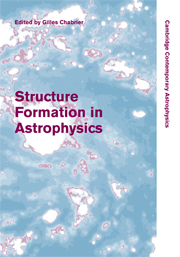Book contents
- Frontmatter
- Contents
- List of contributors
- Preface
- Part I Physical Processes and Numerical Methods Common to Structure Formations in Astrophysics
- 1 The physics of turbulence
- 2 The numerical simulation of turbulence
- 3 Numerical methods for radiation magnetohydrodynamics in astrophysics
- 4 The role of jets in the formation of planets, stars and galaxies
- 5 Advanced numerical methods in astrophysical fluid dynamics
- Part II Structure and Star Formation in the Primordial Universe
- Part III Contemporary Star and Brown Dwarf Formation
- Part IV Protoplanetary Disks and Planet Formation
- Part V Summary
1 - The physics of turbulence
Published online by Cambridge University Press: 11 August 2009
- Frontmatter
- Contents
- List of contributors
- Preface
- Part I Physical Processes and Numerical Methods Common to Structure Formations in Astrophysics
- 1 The physics of turbulence
- 2 The numerical simulation of turbulence
- 3 Numerical methods for radiation magnetohydrodynamics in astrophysics
- 4 The role of jets in the formation of planets, stars and galaxies
- 5 Advanced numerical methods in astrophysical fluid dynamics
- Part II Structure and Star Formation in the Primordial Universe
- Part III Contemporary Star and Brown Dwarf Formation
- Part IV Protoplanetary Disks and Planet Formation
- Part V Summary
Summary
Turbulence in fluids is a topic of great interest. First and foremost, most flows in nature are turbulent and this is particularly true in the astrophysical context (Kritsuk & Norman 2004). Also, turbulence leads to very peculiar mechanics that still escapes to a great extent from our understanding. Since the pioneering works conducted by Osborne Reynolds at the end of the nineteenth century (around 1895), turbulence in fluids has become a rich and challenging research subject in which scientists from engineering, theoretical and experimental physics have been involved with many different perspectives. There is no doubt that bridging ideas from one field to another, and therefore stimulating new interdisciplinary approaches, should provide a fruitful means of gaining understanding on turbulence in the future.
In this chapter, the background physics of turbulence will be discussed spontaneously at a (very) basic level, i.e. without getting into details or precise formulation. The discussion will be limited to incompressible hydrodynamics governed by the Navier-Stokes (NS) equations. Firstly, general comments on turbulence (as a statistical-mechanical problem) will be made. Then, I shall attempt to provide some hints (rather than definite answers) to a series of questions: What is generally the source of turbulence? What are the main statistical features of turbulence? How to deal with turbulence? Much more elaborated developments and references may be sought in the following books (among many others) dealing with turbulence:
a reference book on the physics of turbulence: A first course in turbulence by H. Tennekes and J. L. Lumley, MIT Press, Cambridge, USA (1972)
[…]
- Type
- Chapter
- Information
- Structure Formation in Astrophysics , pp. 3 - 19Publisher: Cambridge University PressPrint publication year: 2009



